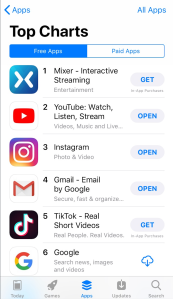This post was done in partnership with Wirecutter. When readers choose to buy Wirecutter's independently chosen editorial picks, Wirecutter and Engadget may earn affiliate commission. Read the full guide to…
Source: Engadget | The best ice cream maker
Source: Engadget | Facebook releases tools to flag harmful content on GitHub
Verizon temporarily drops the 5G fee on its most expensive data plans
August 2, 2019
Source: Engadget | Verizon temporarily drops the 5G fee on its most expensive data plans
In February 2013, China surpassed the United States to become the world’s largest smartphone market. More than half a decade on, it still proves an elusive target for international sellers. A glance at reports from the past several quarters reveals the top spots dominated by homegrown names: Huawei, Vivo, Oppo, Xiaomi.
Combined, the big four made up roughly 84% of the nearly 100 million smartphones shipped last quarter, per new numbers from Canalys. Even international giants like Apple and Samsung have trouble cracking double-digit market share. Of the two, Apple has generally done better, with around 6% of the market — around six times Samsung’s share.
But Apple’s struggles have been very visible nonetheless, as the company has invested a good deal of its own future success into the China market. At the beginning of the year, the company took the rare action of lowering its guidance for Q1, citing China as the primary driver.
“While we anticipated some challenges in key emerging markets, we did not foresee the magnitude of the economic deceleration, particularly in Greater China,” Tim Cook said in a letter to shareholders at the time. “In fact, most of our revenue shortfall to our guidance, and over 100 percent of our year-over-year worldwide revenue decline, occurred in Greater China across iPhone, Mac and iPad.”
When it came time to report, things were disappointing, as expected. The company’s revenue in the area dropped nearly $5 billion, year over year. On the tail of two rough quarters, things picked up a bit for Apple in the country. This week, Tim Cook noted “great improvement” in Greater China.
Source: Tech Crunch Mobiles | A closer look at China’s smartphone market
Source: Engadget | AI and automation are making office life easier
Back to school: The electric skateboards, bikes and scooters to use on campus
August 2, 2019
Source: Engadget | Back to school: The electric skateboards, bikes and scooters to use on campus
Class cancellations for Saturday, August 3, 2019. Refresh this page for updates.
Source: GMA News Lifestyle | Class cancellations for Saturday, August 3, 2019
Source: Engadget | There's now a Razer electric SUV, of course
Source: Engadget | 'No Man's Sky VR' arrives August 14th with 'Beyond' update
Yesterday, Tyler “Ninja” Blevins announced that he’s leaving Twitch, moving his streaming career over to Microsoft’s Mixer platform. This morning, Mixer has shot to the top of the App Store’s free app charts.
Microsoft acquired Mixer in 2016, back when it was called Beam, and has been trying to grow the platform since. However, Mixer has had a tough go of it with competition from the industry leader, Twitch, as well as other tech giants like Google (YouTube) and Facebook.
In fact, Mixer represented just 3% of game streaming viewership hours in the last quarter, according to StreamElements.
Microsoft had this to say about Ninja’s move:
We’re thrilled to welcome Ninja and his community to Mixer. Mixer is a place that was formed around being positive and welcoming from day one, and we look forward to the energy Ninja and his community will bring.

In less than 24 hours, his new Mixer channel has picked up more than 250,000 followers, and Mixer has risen to the top of the App Store charts.
It’s early days for the switch, but it’s still a long way to go to get back to the 14 million followers Ninja enjoyed on Twitch.
Source: Tech Crunch Startups | Following Ninja’s news, Mixer pops to top of the App Store’s free charts